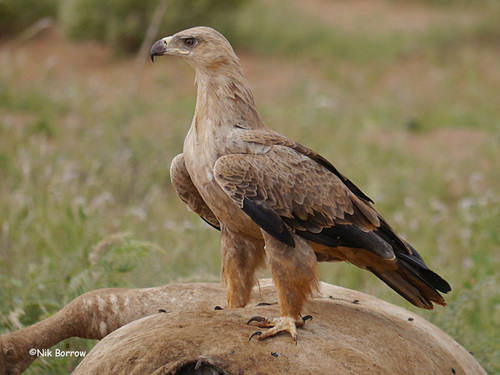
Tawny Eagle
The Tawny Eagle (Aquila rapax) is a large bird of prey found across Africa and the Indian subcontinent. It is a powerful raptor, known for its adaptability to various habitats, from semi-desert to savanna woodlands. Unlike some eagle species that specialize in specific prey, the Tawny Eagle is an opportunistic predator and scavenger, playing a significant role in its ecosystem by controlling populations of small to medium-sized animals and removing carrion. It is not typically considered a bird with significant cultural importance, but its presence is a strong indicator of ecosystem health.
60-75 cm
Length
159-190 cm
Wingspan
Least Concern
Conservation Status
Distribution
The Tawny Eagle has a broad distribution, ranging across most of sub-Saharan Africa and extending into the Indian subcontinent, including parts of India, Pakistan, Nepal, and Bangladesh. It avoids dense forests and true deserts, preferring open habitats. It does not undertake long-distance migrations, although some populations may move locally in response to rainfall and food availability.
Lifespan
The lifespan in the wild is estimated to be around 16 years, but they can live longer in captivity.
Tawny Eagle's Habitat
Habitat Types
Savannas, Open woodlands, Semi-deserts, Grasslands, Agricultural areas (occasionally)
Climate Zones
Tropical, Subtropical, Arid, Semi-arid
Adaptations
Tawny Eagles can tolerate a wide range of temperatures and rainfall conditions. Their broad wings are suited for soaring and gliding, allowing them to cover large areas in search of food with minimal energy expenditure. They have excellent eyesight, crucial for spotting prey from high altitudes.
Variations
Several subspecies have been proposed, with variations in plumage darkness and size, but taxonomic distinctions are often debated. African populations are generally darker than those found in Asia.
Appearance
Breeding Plumage
There is no significant difference in plumage between breeding and non-breeding seasons.
Seasonal Feather Changes
Plumage color can vary considerably, even within the same region, ranging from pale buff to dark brown. This variation is not strictly seasonal but related to individual morphs.
Sex Based Plumage Differences
There is limited sexual dimorphism in plumage color, making it difficult to distinguish males and females based on plumage alone.
Notable Features
Powerful talons, Hooked beak, Variable plumage color (tawny to dark brown), Feathered legs (down to the toes)
Diet and Feeding
Primary Foods
Small mammals (rodents, hares), Birds (up to the size of guineafowl), Reptiles (lizards, snakes), Carrion, Insects (occasionally)
Foraging Behavior
Tawny Eagles hunt by soaring high above the ground, using their keen eyesight to spot prey. They also perch on trees or other vantage points. They are known to steal food from other raptors (kleptoparasitism) and readily feed on carrion.
Specializations
Their strong talons and beak are adapted for tearing flesh. Their digestive system is capable of processing bone and other indigestible materials found in carrion.
Seasonal Diet Variations
Diet may vary depending on prey availability. During the breeding season, they may focus more on live prey to feed their young. In drier periods, they may rely more heavily on carrion.
Behavior
Social Structure
Tawny Eagles are generally solitary or found in pairs. They are not typically found in large flocks, except occasionally at abundant food sources like carcasses.
Communication
Vocalizations (a high-pitched 'kwee-ow' call), Visual displays (aerial displays during courtship)
Migration
Tawny Eagles are generally resident (non-migratory), although some populations may undertake local movements in response to changes in food availability or rainfall.
Territorial or Group Behaviors
They are territorial, defending their nesting and hunting areas from other Tawny Eagles. Pairs maintain their territory year-round.
Conservation
Threats
Habitat loss (due to agriculture and urbanization), Poisoning (both intentional and unintentional), Collision with power lines, Persecution (by farmers who believe they prey on livestock), Reduced prey availability
Protection Programs
Some protected areas exist within their range., Awareness campaigns to reduce persecution.
Local National Laws
Protected under various national wildlife laws in many countries within its range.
Population Trend
Decreasing
Population Estimates
Although listed as Least Concern, the global population is believed to be declining, and it has disappeared from some parts of its former range.
Interesting Facts
They are known for their piratical behavior.
Tawny Eagles often steal food from other birds of prey, a behavior known as kleptoparasitism.
They can have different color morphs.
Individuals can range from pale buff to dark brown, even within the same population.
They are important scavengers.
By consuming carrion, they help to prevent the spread of disease and recycle nutrients within the ecosystem.
African and Asian populations show some differences.
There's ongoing debate about whether they should be considered separate subspecies, or even species.
Faqs about Tawny Eagle
Are Tawny Eagles dangerous to humans?
No, Tawny Eagles are not typically dangerous to humans. They generally avoid human contact and are not large enough to pose a threat.
Do Tawny Eagles attack livestock?
While they may occasionally take small livestock, such as chickens, this is not their primary food source. Their diet consists mainly of wild prey and carrion.
Where can I see a Tawny Eagle?
Tawny Eagles are found in open habitats across Africa and the Indian subcontinent. Good places to look for them include national parks, wildlife reserves, and agricultural areas.
What is the difference between a Tawny Eagle and a Steppe Eagle?
Tawny Eagles (Aquila rapax) are resident breeders, while Steppe Eagles (Aquila nipalensis) are migratory. Immature Steppe Eagles have a distinctive pale band on their underwings, and adults have a gape line that extends beyond the eye, while Tawny Eagle's gape line ends below the middle of the eye.
Copyright @ Nature Style Limited. All Rights Reserved.
 English
English